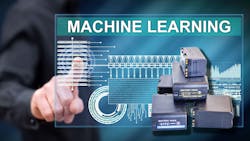Next-Generation Batteries Will Be Brought to You by AI
What you’ll learn:
- The current battery limitations holding back widespread adoption of EVs.
- How artificial intelligence can improve R&D and aid with materials discovery.
- New approaches to battery structure that can be optimized with AI to improve key performance metrics.
The transition to an all-electric future depends on achieving low-cost, higher performing, and safer batteries. Efforts to optimize energy density and power in batteries through next-generation battery chemistries such as solid state have been met with varying degrees of success. However, none have reached the commercialization stage required to meet the exploding demand for advanced technologies such as electric vehicles, medical devices, drones, and energy-storage solutions.
As China, Europe, and America vie to dominate the global battery market, which is projected to reach $279.7 billion by 2027, artificial intelligence (AI) has emerged as a promising tool in accelerating the rate of innovation.
To achieve this, though, next-generation batteries must be able to charge quickly without failure. They also need to surpass current performance standards while maintaining a low weight and consisting of materials that are readily available for mass production.
Researchers have spent decades working on solutions, but progress has been held back by slow experiments, long turnaround times, and a difficult discovery process. AI can help solve these longstanding challenges and reduce the process of evaluating battery materials, cell structure, and chemistries from years to months.
Overcoming Long Evaluation Periods
The traditional way of generating battery performance data involves continually pumping energy into battery cells until they die. Researchers may have to spend years charging and discharging batteries thousands of times over to get the results they need. This is how researchers predict battery degradation, and the process is critical for developing safer batteries that are less prone to combustion. When considering the dramatically increasing, yet relatively new, adoption of electric vehicles and residential solar+storage, it’s clear there’s little time to waste.
Taking a system-level approach, battery scientists can apply AI to more efficiently test and understand battery packs, their integration, and their expected performance. This application of AI also encompasses various cell types, their different chemistries and expected performance, and can help determine the optimal methods for distributing energy within multiple batteries or packs.
Faster, More Effective Materials Discovery
In the past, researchers would be faced with the daunting task of narrowing down the necessary replacement materials for next-generation battery applications. This process required human evaluators pulling insights from the massive troves of data collected from tests. Researchers could only operate as fast as the machines computing the information, which would often take years to generate an advancement.
AI can unlock useful combinations of materials that would not have otherwise been considered. Applying AI to materials discovery has yielded interesting results in many other areas, such as superconductors, and it appears highly promising in batteries.
Optimizing Battery Structure with AI
While most efforts to improve batteries over the last few decades have focused on battery chemistry, changing the physics of batteries has been proven to increase battery density, capacity, safety, and other key performance metrics. AI can help battery scientists better understand structure-property relationships at the electrode level, in order to design the best battery structure for any given application. Depending on how the battery will be used and other technical specifications, AI can make profound recommendations on possible structural designs that result in optimized battery performance.
AI algorithms could even be adapted to suggest possibilities based on emerging technologies and chemistries that haven’t been applied yet. It’s like having a battery-prototyping factory on steroids—a huge benefit to the entire value chain in terms of saved time and cost.
For example, when looking at this through an automotive lens, a high percentage of an EV’s performance is based on the battery cell. That’s why it’s critical to connect it to AI abilities to better understand how to improve not only the battery-management system, but the cell, too. This will prove instrumental in laying the groundwork for next-generation batteries for EV applications.
Will AI Define the Winners and Losers in the Battery Race?
Although AI is still an emerging application in battery science, we’re starting to see more examples of its massive potential. For instance, researchers from Stanford University, the Massachusetts Institute of Technology, and the Toyota Research Institute applied AI to determine the best method for charging an electric-vehicle battery in 10 minutes. While traditional attempts would have required an evaluation process of 500 days, the group was able to identify the best method of charging among 224 candidates in just 16 days using a highly targeted AI algorithm.
It’s not just researchers, but major corporations as well. In partnership with Google, Volkswagen is using AI and quantum computing to simulate and optimize the structure of high-performance batteries. Panasonic claims it has dramatically reduced the number of times it must charge and discharge batteries as it tests new designs, thanks to AI. While these are just a few examples, as machine-learning technology evolves, so will the applications and benefits.
The battery industry is an increasingly crowded playing field with veterans and new entrants alike competing to deliver the next great battery breakthrough. With commercialization of next-generation batteries anywhere from five to 15 years away, maintaining a competitive edge may come down to the successful adoption of AI to accelerate testing phases and identify areas for cost efficiencies and performance improvements.
References
- https://www.globenewswire.com/news-release/2021/04/08/2206703/28124/en/Global-Battery-Market-Report-2020-2027.html
- https://pressroom.toyota.com/mit-stanford-and-toyota-research-institute-use-ai-to-accurately-predict-the-useful-life-batteriesie/
- https://www.wsj.com/articles/electric-car-batteries-get-a-boost-from-artificial-intelligence-11604422792
- https://www.motorauthority.com/news/1113680_google-and-vw-will-use-quantum-computers-to-develop-battery-self-driving-technology
